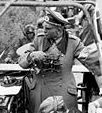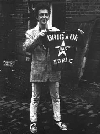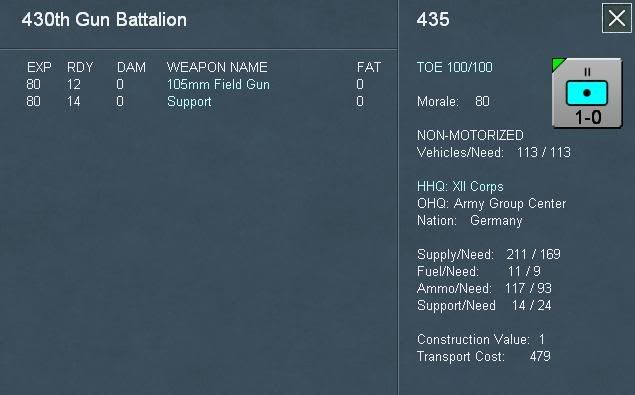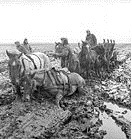ComradeP
Posts: 7192
Joined: 9/17/2009
Status: offline

|
quote:
The tricky (and interesting) aspect of the simulation for me will be to see how quickly the Soviets can put together a good (army level at least) command structure to use their tangible resources (such as army-level support units).
A German corps was often worth more than the sum of its parts, due to the "synergy" bonus given by the German operational and tactical system. More units meant more chances of free flowing battles with ad hoc forces and more possibilities in general.
A Soviet Army was often worth less than the sum of its parts, because the leadership was so poor that, say, 8 Rifle divisions were used as a giant armed mob (in all honesty, a Rifle division often wasn't much more than an armed mob), using numbers rather than the possibilities given by having more units to use in an attack. Even those Guards Mechanized and Tank Corps were often more big than flexible, an unstoppable wave of men and machine crushing depleted German formations.
There are historians who say that the Germans were "outgeneraled" by the Soviets during, say Bagration. In my opinion, the Germans were more often outgeneraled by their own generals and often Hitler than by the Soviets as even in 1945, a determined Soviet assault could still be stopped as long as there was a force to stop it with. The main problem was, of course, that such a force wasn't there. Fighting and winning battles you can't lose doesn't make you a good general.
quote:
Size is not everything. This is the post Purge army we're talking about with such geniuses as Budenny in command. Also most of the Soviet army was dispersed and incapable of offering immediate counterattack. Also the bulk of the armour and aircraft available intially was crappy at best. The men are mostly inexperienced and in low morale. Its not just in C&C that the Red Army was deficient and what passed for a supreme leader and HQ were frankly caught with their pants down.
Funny you'd say "Size is not everything" regarding a War in the East game. In the East, size means a lot. If the Soviet Union had not been so huge, the Soviets would've had nowhere to run to. If their population wasn't big, they would've lost the war.
The Soviet Army in June 1941 was understrength and in most sectors poorly prepared for the Axis attack, true. However, the Soviet player could withdraw his quality formations (especially Rifle Corps and Armoured Divisions which would still be intact), disband many of the less than stellar ones, and get those up to strength.
It would be important to include a penalty on disbanding units that are in contact, or to not make it possible at all, otherwise the Soviet player could simply disband almost all of his initial formations near the border and use the replacements that would give him to boost all the other formations to proper strength in the time it will take the Axis to reach them.
Suck the Axis into the Soviet interior, delaying them with poor formations, and launch a counterattack in the winter. It would be very difficult to have less success than the Soviets did in real life, especially if your objectives are more realistic than what Stalin had in mind (which came down to "surround the majority of Army Group Center and North at the same time").
The Axis player needs to bleed the Soviet Army, by using sensible defensive strategies, by minimizing the amount of offensives that have little strategic value, such as the capture of Stalingrad or Unternehmen Zitadelle and by using the backhand blow method to encircle and destroy the slow moving Soviet army.
If the Soviet player doesn't allow the Axis to establish proper defensive lines when overstretched, can somehow force the Axis player to start offensives that serve little purpose, and advances slowly and methodically in one nationwide human wave that can't be flanked, the Soviet player more or less can't lose.
Infantry experience matters less than numbers if the doctrine ignores the individual and is focussed on the group. The Germans had their soldierly values and in some cases a nearly religious faith in victory, the Soviets had decades of brainwashing which meant that men carried out orders that meant certain death.
I don't believe that the Soviet soldier had low morale, in fact: I have some doubts whether morale was really in issue in many battles. It's all about leadership. As long as the communists were screaming at the peasants that they should advance, they did. When that stopped, confusion set in as the communist system didn't really allow any personal initiative at all (completely opposite to the operational and tactical system used by the Germans).
Many of the early war encirclements were possible because all those hundreds of thousands of men were sheep without a shepherd and thus the majority didn't really try to break out, which in many cases would've been quite possible considering that the Germans barely screened the flanks in the larger encirclements as they couldn't because the infantry was still catching up and the manpower wasn't available.
You'd also think that morale would be low in the winter of 1941-1942, after a long series of defeats, but still the Soviet soldiers died by the thousands in the snow because they were ordered to fight the Germans, who were hiding in the villages. Hardship was an accepted part of life it seemed. The result was many suicidal actions. A loud hurrah, an assault that left many men dead, another loud hurrah, another assault that left many men dead, and so on until the unit was depleted to the bone or the Germans were dead. Up to late 1943 primarily the former, from the beginning of 1944 the latter.
Also, many leaders in the Wehrmacht had a serious case of victory fever after the fall of France and the Balkans and they had no realistic idea of just what the Soviet Union would be capable of militarily, specifically how much damage the Soviet military could take and still function. There were many less brilliant generals on the Axis side too, but the training and initiative of their subordinates did more to cloud that than the "you go where I say you go" system of the Soviets.
quote:
I only disagree with you with size of artylery regiments attached to Soviet Armies as in 1943. there were 3 I think.
I was referring to sectors with active combat, the overall average is probably lower as the Soviets (and the Axis, of course) stripped quiet sectors of everything they could.
That average for early war operations, such as the Smolensk to Moscow period of Barbarossa in 1941 is 4>, the same goes for the battle for Kharkov in 1942 (with one Army getting a grand total of 12 regiments), average for late 1942 operations is lower as the Soviet artillery wasn't very mobile so encirclement battles could often not be supported in strength unless they were slow paced (such as the battle for Stalingrad).
The estimate for the third battle of Kharkov in 1943, is about 3 or 4 regiments for the Soviets, but that includes the not officially assigned Reserve artillery of Voronezh front. At Kursk, 13th Army seems to have had access to the equivalent of a sickening 27 regiments, mostly in the Breakthrough Artillery Corps and attached to the Guards divisions (so not all under Army control).
Early 1944, the average seems to have been around 4 regiments. Bagration's a bit of a black hole for me, I don't have the data on hand to compare the average artillery strength. Early 1945, divisions finally got their own artillery, so armies were drained a bit, but some got some very heavy firepower in the shape of Artillery Divisions, such as during the siege of Budapest.
All in all, I guess the overall average is lower than my 4-8, as it varied a lot in between Armies, but the average of around 4, with some much higher, for Armies in combat zones seem appropriate.
< Message edited by ComradeP -- 12/26/2009 2:08:58 PM >
|
 Printable Version
Printable Version












 hehe
hehe




 New Messages
New Messages No New Messages
No New Messages Hot Topic w/ New Messages
Hot Topic w/ New Messages Hot Topic w/o New Messages
Hot Topic w/o New Messages Locked w/ New Messages
Locked w/ New Messages Locked w/o New Messages
Locked w/o New Messages Post New Thread
Post New Thread